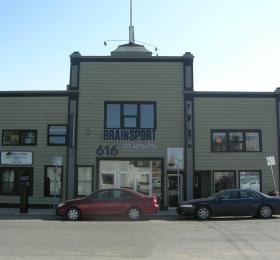Empyreal Building
- Regular
Description of the Historic Place
The Empyreal Building (also known as C.H. Wentz Lumber) is a two storey commercial building located at 616 10th Street East in the neighbourhood of Nutana. Built in 1930, the building is representative of false front architecture and symbolic of Saskatoon’s early lumber industry.
Heritage Value
The Empyreal Building features a simple design with 'false front' architecture, a style known for its vertical extension of the front of a building beyond the roofline. The building, with its clapboard siding, is adorned with decorative pilasters.
In addition to its architecture, the Empyreal building is valued as one of Saskatoon’s earliest lumberyards. Charles H. Wentz had been living in Saskatoon since 1903, and opened a lumber yard for the Canadian Elevator Company. He remained with them until 1906. He then started his own lumber business in 1908 as the Wentz-Birkeland Lumber Co. at 23rd Street and Ontario Avenue. His business grew and by 1914 he bought out his partner and became the sole proprietor of the (C.H.) Wentz Lumber Company. By 1920 he was the vice-president of Blain-Wentz Land Co. and the general superintendent of Reliance Lumber Co. Ltd. In 1926 Wentz created a new company - C.H. Wentz Lumber Co. Ltd. - located at 618 10th Street East. Wentz was a member of the Saskatoon Club, Saskatoon Industrial League, the Masons, Saskatchewan Lodge No. 16, the Shriners, and the Odd Fellows.
The C.H. Wentz Lumber Co. Ltd. business remained at 616 10th Street East until 1962. An adaptive reuse project occurred in the 1990s and through the City's Heritage Awards Program, the building received an award for renovation of a commercial building in 1992. Recently, the building has again undergone exterior and extensive interior work that is sympathetic to the building's original character. In 2016 the building received a heritage award for adaptive reuse, and one for heritage space, under the City's heritage awards program.
Source: City of Saskatoon Built Heritage Database
Character Defining Elements
Key elements which contribute to the heritage value of this historic resource include:
- Its false-front style of architecture, evident in: its simple design, clapboard siding, decorative pilasters, and pediment; and
- Those features that relate to its historical significance, including its form, massing, scale and original location.

